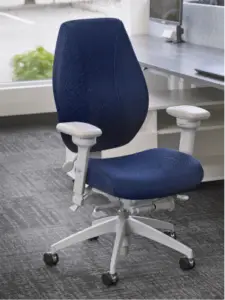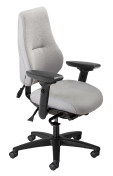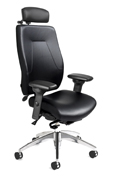The first article described how the CSA Standard for Office Ergonomics Z412-17 has changed.
The second article discussed the important concepts.
This article describes the office work system and highlights the requirement to accommodate everyone in the workspace.
The office work system
Planning and designing an office space requires consideration of the total office work system. It involves considering more than the furniture, equipment, and work accessories that are used, the layout of the space, and the lighting, noise, temperature and indoor air quality.
The work system is broad in scope. It also includes the way that work is structured, supervised, and carried out, how various parts and components function and interact, and the psychological components that affect the employees’ health and well-being.
The Z412-17 standard specifies requirements that apply to both traditional office spaces and to non-traditional office spaces (such as home offices, vehicles, and temporary work locations). An example of one such requirement is the need to accommodate everyone in the workspace.
Need to accommodate everyone in the office workspace
Employers are aware of the obligation to accommodate a person who has a specific physical, sensory, or other medical requirement. The Canadian Human Rights Commission illustrates this “duty to accommodate” by explaining that sometimes it is necessary to treat someone differently in order to prevent or reduce discrimination.
In previous CSA Office Ergonomics documents (Z412-M89 and Z412-00, which are now superseded by Z412-17) the reader might reach the conclusion that it was only necessary to provide chairs and workstations that were appropriate for employees whose standing height is in the range between a short female and a tall male. This reasoning is plausible since the tables in these documents provided body dimensions that ranged from a petite (5th percentile) female to that of a tall (95th percentile) male.
CSA Z412-17 is a higher standard. It states that the individual user of the office workspace needs to be accommodated.
Annex A, which is a mandatory part of the standard, assists in evaluating whether or not each individual is accommodated in the workspace. Figures in the Annex illustrate the referenced working postures and tables provide dimensions and adjustment ranges. Annex A also provides principles for determining the suitability of a workstation and requirements for work chairs and work surfaces.
Accommodating everyone in a work chair
The considerations for selecting an office work chair are much more involved than simply providing stable support.
The standard specifies that the work chair needs to accommodate the relevant characteristics of each employee. It also requires that the work chair is appropriate for the tasks or activities being performed and allow for movement through multiple postures.
The determination of whether a work chair does accommodate each user is based on various body (anthropometric) dimensions. For example: knee (popliteal) height determines the appropriate height for the seat; support for the lumbar region of the spine requires a backrest that is adjustable in height; the length of the upper leg (buttock to popliteal length) determines the required depth for the seat; and the breadth of the hip determines the width required for the seat and the arm rests.
Most employees are accommodated in chairs that have been designed to accommodate the 5th percentile female body dimensions to the 95th percentile male body dimensions. However, the new standard states that selecting an appropriate work chair is complex and mentions that, depending on the user population, multiple product solutions could be required to accommodate every user.
Accommodating everyone at work surfaces
The standard also has the requirement that furniture accommodate the relevant anthropometric characteristics of the employee who uses the workstation.
Criteria provided for determining if a work and support surface accommodates each user include:
- being appropriate for the tasks or activities assigned;
- providing support for the technology and associated equipment/materials used;
- and allowing movement through multiple postures.
Height-adjustable tables allow movement through multiple postures.
Height-adjustable tables are ideal for those situations where more than one individual is assigned to that work surface. Since these tables are adjusted easily, each employee can quickly adjust the height of the work surface to achieve the recommended postures.
When seated, clearance under any work surface needs to allow free movement through multiple postures, including extending the lower legs.
The anthropometric dimensions for determining whether the work surfaces accommodate each user when seated include consideration of thigh height, popliteal height, knee height and ankle height for the height clearance, and buttock to knee length, abdominal extension and foot length for the depth clearance under a work surface.
Similar to the approach for the work chair, work-surface-related dimensions and ranges to accommodate the 5th percentile female to the 95th percentile male are provided in Annex A.
It is noted that meeting the requirements for all users in a population can require dimensions and ranges outside of the dimensions that are provided. Such determinations can be complex, so CSA specifies that the assessment be performed by a competent person.
The standard provides definitions for a competent person and for an Ergonomist.
Contact the Association of Canadian Ergonomists/Association Canadienne d’Ergonomie to find a Canadian Certified Professional Ergonomist (CCPE).
Stay informed!
You can purchase your copy of CSA Z412-17 here








